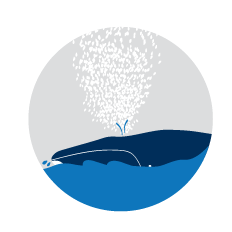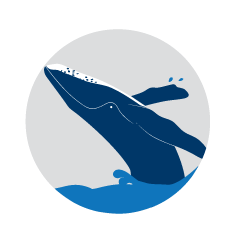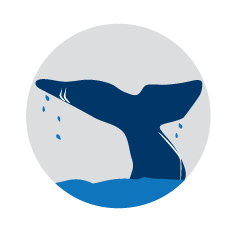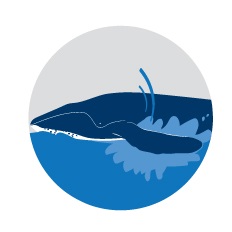Whales making a splash
Spot a whale on our whale watching walks
Join one of our guided morning walks spotting whales along the windswept cliff lines between Lighthouse Reserve and Gap Park. Choose from three walk dates: Sunday 15 June, Sunday 13 July or Tuesday 15 July. Register here
Humpback whales are renowned for an array of spectacular behaviours you may see from our coastal paths at Vaucluse and Gap Park.
Every year more than 40,000 humpbacks travel from the cool feeding waters of the Antarctic, to warmer, shallower waters off the coast of Queensland. From mid-May to mid- August they migrate 5,000 km north to calve and mate.
Mid-August to November sees whales heading south. They may travel further away from the coast to take advantage of southerly currents. Mothers return more slowly with their calves from September to November.
Which of these whale behaviours will you spot this season?

Blowing - one of the best ways to start looking for whales is to scan over the ocean, looking for spray when they expel air from their lungs as they come up to breathe. They blow water 3-5 meters in the air as they come up. Humbacks usually surface every 4-7 minutes, so be patient and scan an area for a few minutes when you’re trying to spot them.

Breaching - whales use two to three movements of their powerful tails to launch themselves out of the water, then roll in the air with their huge pectoral fins outstretched like wings, and crash back into the water with splash. During the southerly migration you may be lucky enough to see a mother teaching her calf to breach.

Spy Hopping - whales sometimes poke their heads above the surface. It is believed this is to orient themselves to the shoreline and observe their surroundings. They have good eyesight both above and below the water.

Fluke-up dive - when diving forward in the water whales leave their tales arched upward. The angle of the tail will help indicate whether they will be diving deeper or shallower.

Slapping - whales slap the water surface using their fins or tail. These actions are thought to be a form of communication or warning.
Where to find binoculars?
As you stroll along our coastal pathways this whale season look out for our public binoculars and whale signs at Jacobs Ladder in Gap Park and the southern corner of Christison Park. We've put these in place to help everyone observe and learn more about our whales, other marine mammals and coastal birds.
More information